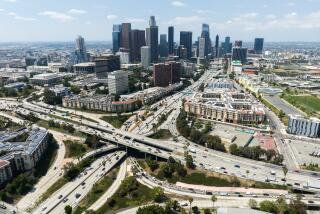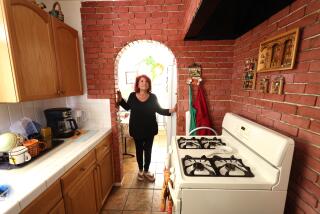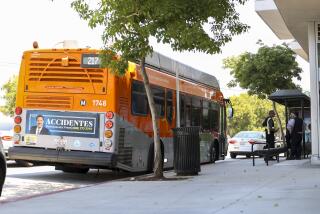With Funding in Place, Valley Debates North-South Busway
- Share via
A big clue that something was afoot was the recent subway grand opening party in North Hollywood.
Although it was a full week before Gov. Gray Davis would sign the budget, it was clear from all the congratulatory back-slapping and the confident speeches that the San Fernando Valley would score several substantial transportation allocations, including a surprising $100 million for a north-south corridor to serve northeast communities such as Pacoima and Sylmar.
All the crowing was not for naught.
As expected, Davis approved the budget, and Valley officials are now eagerly exploring several ideas to help ease travel within the Valley and beyond.
The budget allocates $145 million for an east-west busway on Burbank and Chandler boulevards, a long-sought project that has been on politicians’ wish lists for decades.
The north-south project is a newcomer. Yet several concepts for it, all of which involve bus transportation, are already percolating.
A dedicated bus lane from the North Hollywood Red Line station, north on Lankershim Boulevard to San Fernando Road, is the favored route of state Sen. Richard Alarcon (D-Sylmar). He said the route could follow the San Fernando Road railroad right of way. The buses would travel through the city of San Fernando to Sylmar.
Alarcon, a former board member of the Metropolitan Transportation Authority and Metrolink, doesn’t believe a separate bus lane could be so easily designed for Van Nuys Boulevard, though that street is also a candidate.
The northeast and eastern Valley areas have a long history of high bus ridership, Alarcon said, and many passengers are working-class families who need to get to jobs and often don’t have cars. Bus lines are historically well used, but the area deserves more, he said.
“I used to ride the bus from Sun Valley to St. Genevieve High School in Panorama City. My grandmother used to ride a bus from Sun Valley to downtown L.A.,” he said. “It is hard to train car users to get out of a car to use a mass transit system. It can be done, but it is much easier and more feasible to get people who aren’t using cars to use mass transit.”
Van Nuys and Sepulveda boulevards are also candidates. Though Van Nuys has many businesses along the street, a dedicated bus lane might mean less street parking, said Los Angeles County Supervisor Zev Yaroslavsky.
“I think this $100 million goes a long way toward this project,” said Yaroslavsky, an MTA board member. “The hard part is convincing the public that this is worthy of a try. . . . We have to have the courage to try something that works.”
The key, he said, is to make sure a north-south transit route is linked to other public transportation in the Valley and to the rest of the city. A new corridor should intersect with the east-west bus corridor, the new rapid-bus project on Ventura Boulevard, or the Metrolink station in San Fernando/Sylmar. The rapid-bus experiment, which began last month, allows green lights to be extended as buses approach intersections.
After a trip to Curitiba, Brazil, a year and a half ago, Yaroslavsky said he, Assembly Speaker Bob Hertzberg (D-Sherman Oaks) and other leaders decided to push for a similar system here, one that travels nearly 40 mph on its own lane with articulated buses that have up to three sections joined by accordion-like connectors.
The $100 million might pay for half, perhaps even three-quarters of such a “light rail on rubber tires” project, and the MTA should pick up the balance, he said.
The money will be a good start to funding such a project, said David Fleming, a former member of the California Transportation Commission and now head of the Economic Alliance of the San Fernando Valley.
Compared to rail projects, a bus system is about one-tenth as costly to build per mile, supporters of bus systems say.
The alliance conducted a survey about a year ago that found 75% of Valley residents also work in the Valley, Fleming said. A fast bus system is crucial for transit-dependent northeast Valley residents.
That section of the city has long deserved a project, but the state didn’t have the kind of surplus that it enjoys today, officials said. “When I was on the CTC from 1996 to 1999, we didn’t have money to even maintain the system, much less build new parts,” Fleming said. “And money from federal funds are basically for rail; they stressed rail transit, not bus transit.”
With nine regular bus lines running along portions of Van Nuys Boulevard, that corridor is the MTA’s 12th busiest, said MTA spokesman Ed Scannell.
Councilman Alex Padilla, who represents the northeast section of the city, said whether the route is on Van Nuys or Lankershim boulevards or another route, rapid bus is just one solution that should be considered.
Plans are very conceptual at this point, he said. As early as this week he wants to begin talks with the city’s Department of Transportation and the MTA to develop proposals. The key to heavy use is to tie the Valley bus corridor to other existing transit, Padilla said.
“To effectively address transportation in the Valley, you can’t just think east-west,” Padilla said. “You also have to think north-south.”
More to Read
Sign up for Essential California
The most important California stories and recommendations in your inbox every morning.
You may occasionally receive promotional content from the Los Angeles Times.










